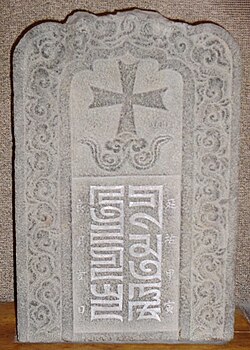'Phags-pa script
| 'Phags-pa ꡖꡍꡂꡛ ꡌ |
|
|---|---|

|
|
| Type | |
| Languages | |
| Creator | Drogön Chögyal Phagpa |
|
Time period
|
1269 – c. 1360 |
|
Parent systems
|
|
|
Child systems
|
possibly Hangul |
|
Sister systems
|
Lepcha |
| Direction | Top-to-bottom |
| ISO 15924 | Phag, 331 |
|
Unicode alias
|
Phags-pa |
| U+A840–U+A87F | |
|
[a] The Semitic origin of the Brahmic scripts is not universally agreed upon.
|
|
The 'Phags-pa script (Mongolian: дөрвөлжин үсэг "Square script") is an alphabet designed by the Tibetan monk and State Preceptor (later Imperial Preceptor) Drogön Chögyal Phagpa for Kublai Khan, the founder of the Yuan dynasty, as a unified script for the written languages within the Yuan. The actual use of this script was limited to about a hundred years during the Mongol Yuan dynasty, and it fell out of use with the advent of the Ming dynasty. The documentation of its use provides clues about the changes in the varieties of Chinese, the Tibetic languages, Mongolian and other neighboring languages during the Yuan era.
The Uyghur-based Mongolian alphabet is not a perfect fit for the Middle Mongol language, and it would be impractical to extend it to a language with a very different phonology like Chinese. Therefore, during the Yuan dynasty (circa 1269), Kublai Khan asked 'Phags-pa to design a new alphabet for use by the whole empire. 'Phags-pa extended his native Tibetan alphabet, one of the Brahmic scripts, to encompass Mongol and Chinese, evidently Central Plains Mandarin. The resulting 38 letters have been known by several descriptive names, such as "square script" based on their shape, but today are primarily known as the 'Phags-pa alphabet.
Despite its origin, the script was written vertically (top to bottom) like the previous Mongolian scripts. It did not receive wide acceptance, and was not a popular script even among the elite Mongols themselves, although it was used as an official script of the Yuan dynasty until the early 1350s when the Red Turban Rebellion started. After this it was mainly used as a phonetic gloss for Mongolians learning Chinese characters. It was also used as one of the scripts on Tibetan currency in the twentieth century, as script for Tibetan seal inscriptions from the Middle Ages up to the 20th century and for inscriptions on the entrance doors of Tibetan monasteries.
...
Wikipedia
